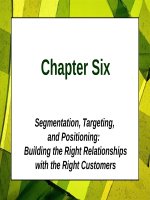Lecture Principles of Marketing - Chapter 5: Consumer and business buyer behavior
Bạn đang xem bản rút gọn của tài liệu. Xem và tải ngay bản đầy đủ của tài liệu tại đây (246.64 KB, 35 trang )
Chapter Five
Consumer and Business
Buyer Behavior
Roadmap: Previewing the Concepts
1. Understand the consumer market and the
major factors that influence consumer buyer
behavior.
2. Identify and discuss the stages in the buyer
decision process.
3. Describe the adoption and diffusion process
for new products.
4. Define the business market and identify the
major factors that influence business buyer
behavior.
5. List and define the steps in the business
buying decision process.
Copyright 2007, Prentice Hall, Inc.
5-2
Case Study
HarleyDavidson – Devoted Consumers
Building Success
Measuring Success
Offers good bikes,
upgraded showrooms
and sales tactics.
Research has helped to
understand customers’
emotions and motivation.
Consumer emotions,
motivations, and lifestyle
have been translated into
effective advertising.
Currently has 23% of all
U.S. bike sales and 50% of
heavyweight segment.
Demand above supply with
waiting lists up to 2 years.
Sales doubled in the past
six years while earnings
have tripled.
2005: 19th straight year of
record sales and income.
Consumer Buying Behavior
Refers to the buying behavior of people
who buy goods and services for
personal use.
These people make up the consumer
market.
The central question for marketers is:
– “How do consumers respond to various
marketing efforts the company might
use?”
Model of Buying Behavior
Marketing factors and other stimuli are
inputs into the “buyer’s black box.”
Here, stimuli are evaluated in light of
the buyer decision process and the
buyer’s characteristics.
Buyer responses influence choice of
the product, brand, vendor, as well as
the timing and amount of purchase.
Culture
Culture is the most basic cause of a
person's wants and behavior.
– Culture is learned from family, church,
school, peers, colleagues.
– Culture reflects basic values, perceptions,
wants, and behaviors.
– Cultural shifts create opportunities for new
products or may otherwise influence
consumer behavior.
Consumer Buying Behavior
Factors influencing consumer behavior:
– Cultural factors:
• Culture, subculture, social class
– Social factors:
• Reference groups, family, roles and status
– Personal factors:
• Age/life-cycle, occupation, economic situation,
lifestyle, personality and self-concept
– Psychological factors:
• Motivation, perception, learning, beliefs, and
attitudes
Culture
Subculture
– Groups of people with shared value
systems based on common life
experiences.
Major Groups
– Hispanic Consumers
– African-American Consumers
– Asian-American Consumers
– Mature Consumers
Social Class
Society’s relatively permanent and
ordered divisions whose members
share similar values, interests, and
behaviors.
Measured by a combination of:
occupation, income, education, wealth,
and other variables.
Social Factors
Groups:
– Membership, Reference (Opinion Leaders),
Aspirational
Family:
– Most important consumer buying
organization
Roles and Status:
– Role = Expected activities
– Status = Esteem given to role by society
Personal Factors
Age and Life-Cycle Stage
– People change the goods they buy over
their lifetimes.
Occupation
– Occupation influences the purchase of
clothing and other goods.
Economic Situation
– Some goods and services are especially
income-sensitive.
Personal Factors
Lifestyle:
– Pattern of living as expressed in
psychographics
• Activities
• Interests
• Opinions
Personality & Self-Concept
Personality refers to the unique
psychological characteristics that lead
to relatively consistent and lasting
responses to one’s own environment.
Generally defined in terms of traits.
Self-concept suggests that people’s
possessions contribute to and reflect
their identities.
Motives and Needs
A motive (or drive)
is a need that is
sufficiently pressing
to direct the person
to seek satisfaction.
Maslow’s hierarchy
of needs explains
why people are
driven by needs at
particular times.
Maslow’s hierarchy
of needs implies
that lower level
needs must be
satisfied prior to
higher level needs.
–
–
–
–
–
Physiological needs
Safety needs
Social needs
Esteem needs
Self-Actualization
Perception
Process by which people select,
organize, and interpret information to
form a meaningful picture of the world.
– Selective attention
– Selective distortion
– Selective retention
Learning
A relatively permanent change in behavior
due to experience.
Interplay of drives, stimuli, cues, responses,
and reinforcement.
Strongly influenced by the consequences of
an individual’s behavior
– Behaviors with satisfying results tend to be
repeated.
– Behaviors with unsatisfying results tend not to be
repeated.
Beliefs & Attitudes
A belief is a descriptive thought that a
person holds about something.
An attitude is a person’s consistently
favorable or unfavorable evaluations,
feelings, and tendencies toward an
object or idea.
Buying Decision Process
Need recognition
Information search
Evaluation of alternatives
Purchase decision
Postpurchase behavior
Sources of Information
Personal
Commercial
Public
Experiential
Buying Decision Process
Factors that influence purchase
decision:
– Attitudes of others
– Unexpected situational factors
Buying Decision Process
Consumer satisfaction is a function of
consumer expectations and perceived
product performance.
– Performance < Expectations ----- Disappointment
– Performance = Expectations ----- Satisfaction
– Performance > Expectations ----- Delight
Buying Decision Process
Cognitive dissonance: a buyer’s
doubts shortly after a purchase about
whether it was the right decision.
Stages in the Adoption
Process
1. Awareness: Consumer becomes aware of the
2.
3.
4.
5.
new product, but lacks information about it.
Interest: Consumer seeks information about new
product.
Evaluation: Consumer considers whether trying
the new product makes sense.
Trial: Consumer tries new product on a small
scale to improve his or her estimate of its value.
Adoption: Consumer decides to make full and
regular use of the new product.
Product Adopter Categories
Innovators
Early adopters
Early majority
Late majority
Laggards
Product Characteristics That
Influence the Rate of Adoption
Relative Advantage: Is the innovation
superior to existing products?
Compatibility: Does the innovation fit the
values and experience of the target market?
Complexity: Is the innovation difficult to
understand or use?
Divisibility: Can the innovation be used on a
limited basis?
Communicability: Can results be easily
observed or described to others?









